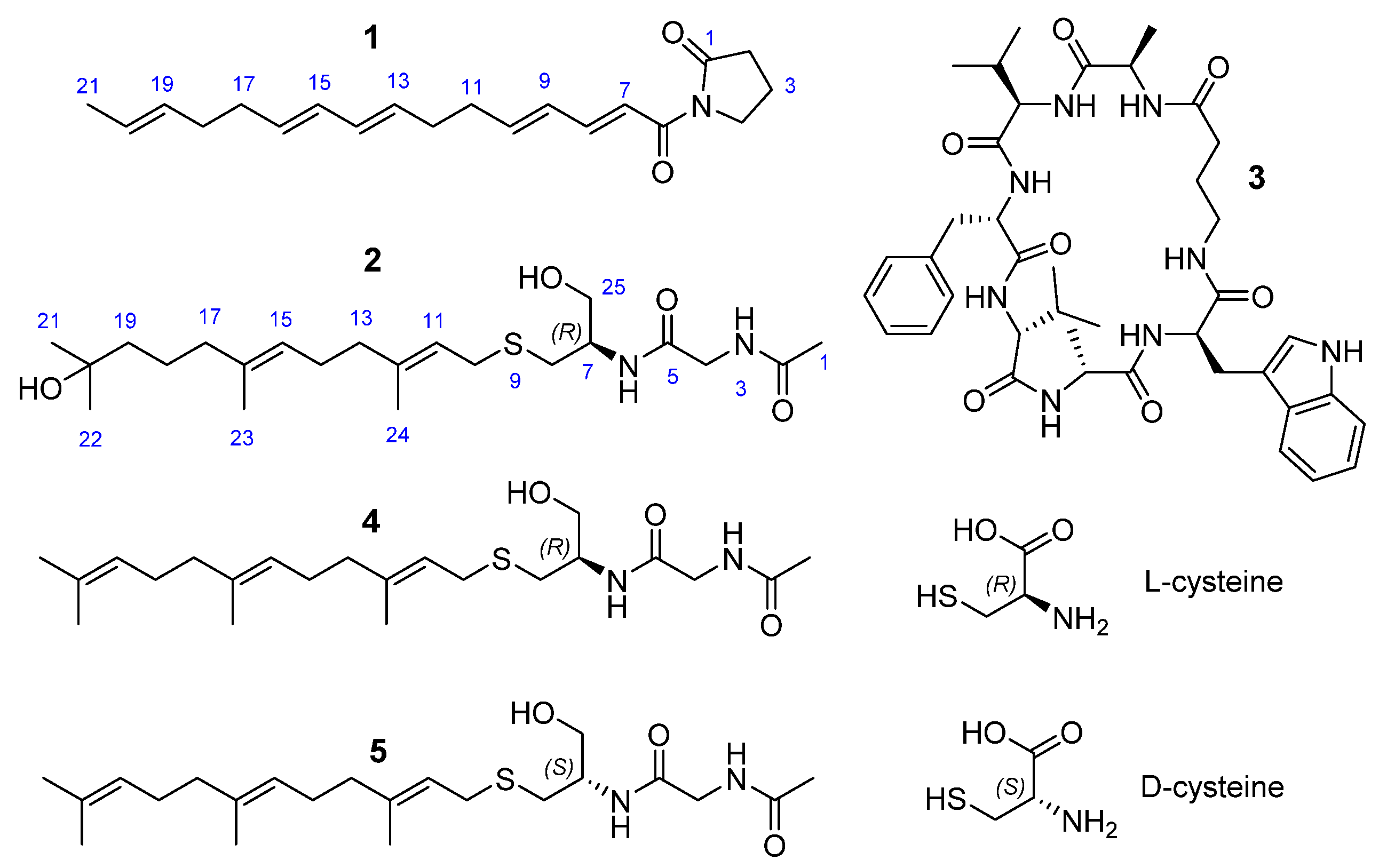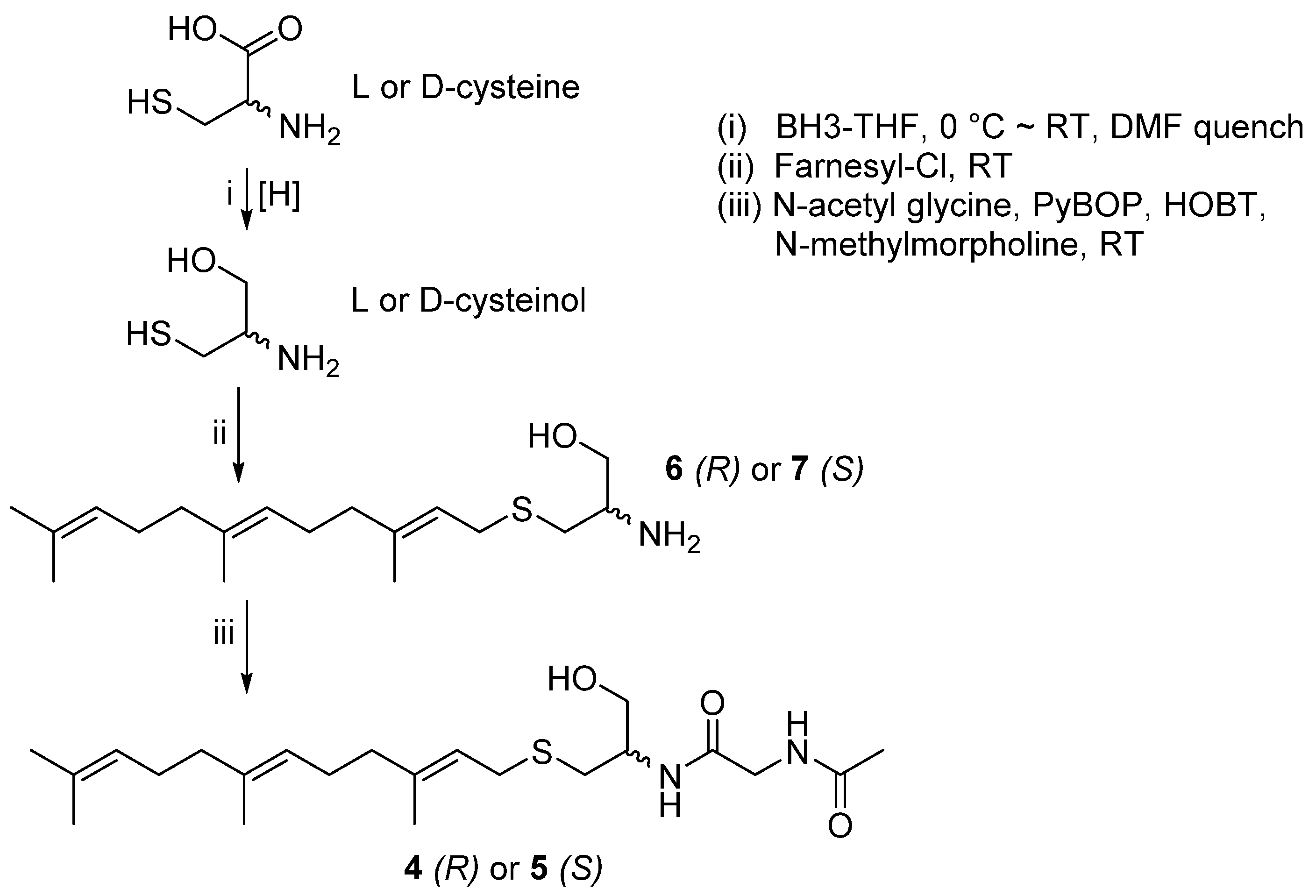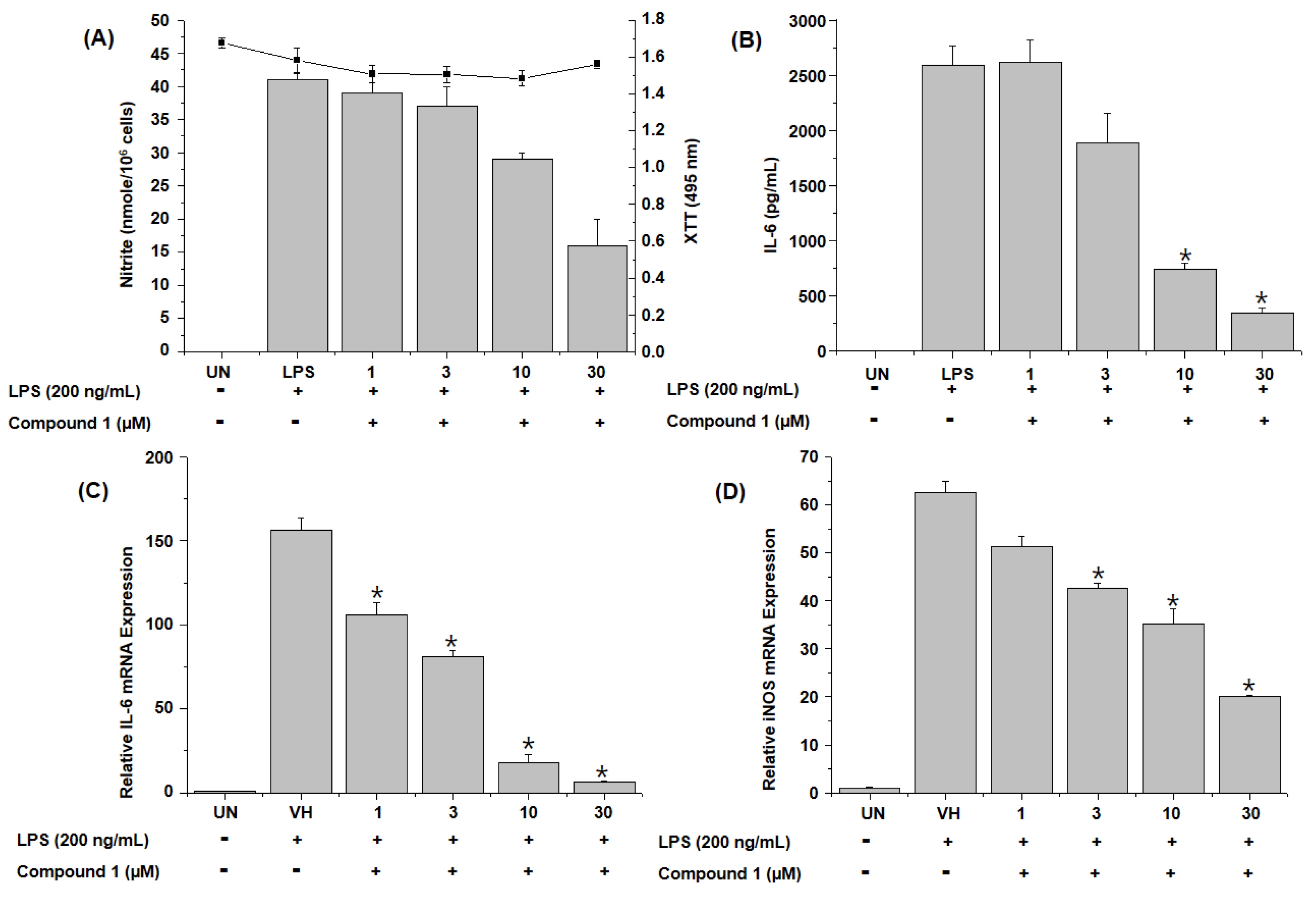Nitrogen-Containing Secondary Metabolites from a Deep-Sea Fungus Aspergillus unguis and Their Anti-Inflammatory Activity
Abstract
:1. Introduction
2. Results and Discussion
3. Materials and Methods
3.1. General Experimental Procedures
3.2. Fungal Material, Fermentation, and Isolation of Secondary Metabolites
Fungal Material, Fermentation, and Isolation of 1–3 from Aspergillus unguis IV17-109
3.3. Synthesis of 4 and 5
3.4. Anti-Inflammatory Assay
4. Conclusions
Supplementary Materials
Author Contributions
Funding
Institutional Review Board Statement
Informed Consent Statement
Data Availability Statement
Acknowledgments
Conflicts of Interest
References
- Skropeta, D.; Wei, L. Recent advances in deep-sea natural products. Nat. Prod. Rep. 2014, 31, 999–1025. [Google Scholar] [CrossRef] [PubMed]
- Andrianasolo, E.; Lutz, R.; Falkowski, P. Chapter 3—Deep-Sea Hydrothermal Vents as a New Source of Drug Discovery. Stud. Nat. Prod. Chem. 2012, 36, 43–66. [Google Scholar]
- Pan, C.; Shi, Y.; Chen, X.; Chen, C.-T.A.; Tao, X.; Wu, B. New compounds from a hydrothermal vent crab-associated fungus Aspergillus versicolor XZ-4. Org. Biomol. Chem. 2017, 15, 1155–1163. [Google Scholar] [CrossRef] [PubMed]
- Youssef, F.S.; Ashour, M.L.; Singab, A.N.B.; Wink, M. A Comprehensive Review of Bioactive Peptides from Marine Fungi and Their Biological Significance. Mar. Drugs 2019, 17, 559. [Google Scholar] [CrossRef] [PubMed] [Green Version]
- Henke, M.T.; Soukup, A.A.; Goering, A.W.; McClure, R.A.; Thomson, R.J.; Keller, N.P.; Kelleher, N.L. New Aspercryptins, Lipopeptide Natural Products, Revealed by HDAC Inhibition in Aspergillus nidulans. ACS Chem. Biol. 2016, 11, 2117–2123. [Google Scholar] [CrossRef] [PubMed] [Green Version]
- Malmstrøm, J. Unguisins A and B: New Cyclic Peptides from the Marine-Derived Fungus Emericella unguis. J. Nat. Prod. 1999, 62, 787–789. [Google Scholar] [CrossRef] [PubMed]
- Li, W.; Jiao, F.-W.; Wang, J.-Q.; Shi, J.; Wang, T.-T.; Khan, S.; Jiao, R.-H.; Tan, R.-X.; Ge, H.-M. Unguisin G, a new kynurenine-containing cyclic heptapeptide from the sponge-associated fungus Aspergillus candidus NF2412. Tetrahedron Lett. 2020, 61, 152322. [Google Scholar] [CrossRef]
- Pahwa, R.; Goyal, A.; Jialal, I. Chronic Inflammation; StatPearls Publishing: Treasure Island, FL, USA, 2021. Available online: https://www.ncbi.nlm.nih.gov/books/NBK493173/ (accessed on 25 February 2022).
- Lee, H.-S.; Kang, J.S.; Choi, B.-K.; Lee, H.-S.; Lee, Y.-J.; Lee, J.; Shin, H.J. Phenazine Derivatives with Anti-Inflammatory Activity from the Deep-Sea Sediment-Derived Yeast-Like Fungus Cystobasidium laryngis IV17-028. Mar. Drugs 2019, 17, 482. [Google Scholar] [CrossRef] [PubMed] [Green Version]
- Anh, C.V.; Kwon, J.-H.; Kang, J.S.; Lee, H.-S.; Heo, C.-S.; Shin, H.J. Antibacterial and Cytotoxic Phenolic Polyketides from Two Marine-Derived Fungal Strains of Aspergillus unguis. Pharmaceuticals 2022, 15, 74. [Google Scholar] [CrossRef] [PubMed]
- Yonehara, H.; Takeuchi, S.; Umezawa, H.; Sumiki, Y. Variotin, a new antifungal antibiotic, produced by Paecilomyces varioti Bainier var. antibioticus. J. Antibiot. 1959, 12, 109–110. [Google Scholar]
- Podkorytov, I.S.; Lubnin, A.V. 13C NMR spectra of the models for the end-group analysis of polybutadiene. Magn. Reson. Chem. 1991, 29, 561–565. [Google Scholar] [CrossRef]
- Ishii, T.; Nonaka, K.; Sugawara, A.; Iwatsuki, M.; Masuma, R.; Hirose, T.; Sunazuka, T.; Ōmura, S.; Shiomi, K. Cinatrins D and E, and virgaricin B, three novel compounds produced by a fungus, Virgaria boninensis FKI-4958. J. Antibiot. 2015, 68, 633–637. [Google Scholar] [CrossRef] [PubMed]
- Vertesy, L.; Ehrlich, K.; Segeth, P.; Toti, L. Coniosulfides and Their Derivatives, Processes for Preparing Them, and Their Use as Pharmaceuticals. U.S. Patent US 2005/0209308A1, 22 September 2005. [Google Scholar]
- Majmudar, J.D.; Morrison-Logue, A.; Song, J.; Hrycyna, C.A.; Gibbs, R.A. Identification of a novel nanomolar inhibitor of hIcmt via a carboxylate replacement approach. Med. Chem. Comm. 2012, 3, 1125–1137. [Google Scholar] [CrossRef]
- Voronkov, M.; Perez, E.; Healy, J.; Fernandez, J. Preparation of Amino Acids for Treating or Preventing Inflammation, Acne, and Bacterial Conditions. International Patent WO 2018/132759 Al, 19 July 2018. [Google Scholar]
- Rodriguez, D.; Ramesh, C.; Henson, L.H.; Wilmeth, L.; Bryant, B.K.; Kadavakollu, S.; Hirsch, R.; Montoya, J.; Howell, P.R.; George, J.M.; et al. Synthesis and characterization of tritylthioethanamine derivatives with potent KSP inhibitory activity. Bioorg. Med. Chem. 2011, 19, 5446–5453. [Google Scholar] [CrossRef] [PubMed] [Green Version]
- Hwang, J.-Y.; Park, S.C.; Byun, W.S.; Oh, D.-C.; Lee, S.K.; Oh, K.-B.; Shin, J. Bioactive Bianthraquinones and Meroterpenoids from a Marine-Derived Stemphylium sp. Fungus. Mar. Drugs 2020, 18, 436. [Google Scholar] [CrossRef] [PubMed]
- Shin, H.J.; Heo, C.-S.; Anh, C.V.; Yoon, Y.D.; Kang, J.S. Streptoglycerides E–H, Unsaturated Polyketides from the Marine-Derived Bacterium Streptomyces specialis and Their Anti-Inflammatory Activity. Mar. Drugs 2022, 20, 44. [Google Scholar] [CrossRef]




| Compound | 1 | 2 | ||
|---|---|---|---|---|
| Position | δH, mult (J in Hz) | δC | δH, mult (J in Hz) | δC |
| 1 | 177.8 | 2.01, s | 22.5 | |
| 2 | 2.61, t (8.1) | 34.6 | 173.9 | |
| 3 | 2.04, m | 18.1 | ||
| 4 | 3.82, m | 47.0 | 3.86, m | 43.6 |
| 5 | 171.5 | |||
| 6 | 168.2 | |||
| 7 | 7.25, d (15.1) | 121.7 | 4.03, m | 52.3 |
| 8 | 7.37, dd (15.1, 10.8) | 146.9 | 2.55–2.70 | 32.9 |
| 9 | 6.32, dd (15.1, 10.8) | 130.7 | ||
| 10 | 6.23, m | 146.0 | 3.16–3.22 | 30.3 |
| 11 | 2.29, q (6.6) | 34.0 | 5.23, td (7.8, 1.0) | 121.8 |
| 12 | 2.21, m | 32.8 | 140.1 | |
| 13 | 5.56, td (13.6, 6.6) | 131.6 | 2.06, m | 40.7 |
| 14 | 6.01, m | 132.6 | 2.13, m | 27.4 |
| 15 | 6.01, m | 131.8 | 5.13, td (6.8, 1.0) | 125.2 |
| 16 | 5.56, td (13.6, 6.6) | 133.1 | 136.3 | |
| 17 | 2.10, dd (14.1, 6.8) | 33.6 | 1.98, t (7.2) | 41.3 |
| 18 | 2.04, m | 33.8 | 1.46, m | 23.7 |
| 19 | 5.44, m | 131.9 | 1.40, m | 44.3 |
| 20 | 5.44, m | 126.1 | 71.4 | |
| 21 | 1.62, d (4.5) | 18.1 | 1.17, s | 29.2 |
| 22 | 1.17, s | 29.2 | ||
| 23 | 1.61, s | 16.0 | ||
| 24 | 1.68, s | 16.2 | ||
| 25 | 3.62, m | 63.6 | ||
Publisher’s Note: MDPI stays neutral with regard to jurisdictional claims in published maps and institutional affiliations. |
© 2022 by the authors. Licensee MDPI, Basel, Switzerland. This article is an open access article distributed under the terms and conditions of the Creative Commons Attribution (CC BY) license (https://creativecommons.org/licenses/by/4.0/).
Share and Cite
Anh, C.V.; Yoon, Y.D.; Kang, J.S.; Lee, H.-S.; Heo, C.-S.; Shin, H.J. Nitrogen-Containing Secondary Metabolites from a Deep-Sea Fungus Aspergillus unguis and Their Anti-Inflammatory Activity. Mar. Drugs 2022, 20, 217. https://doi.org/10.3390/md20030217
Anh CV, Yoon YD, Kang JS, Lee H-S, Heo C-S, Shin HJ. Nitrogen-Containing Secondary Metabolites from a Deep-Sea Fungus Aspergillus unguis and Their Anti-Inflammatory Activity. Marine Drugs. 2022; 20(3):217. https://doi.org/10.3390/md20030217
Chicago/Turabian StyleAnh, Cao Van, Yeo Dae Yoon, Jong Soon Kang, Hwa-Sun Lee, Chang-Su Heo, and Hee Jae Shin. 2022. "Nitrogen-Containing Secondary Metabolites from a Deep-Sea Fungus Aspergillus unguis and Their Anti-Inflammatory Activity" Marine Drugs 20, no. 3: 217. https://doi.org/10.3390/md20030217
APA StyleAnh, C. V., Yoon, Y. D., Kang, J. S., Lee, H.-S., Heo, C.-S., & Shin, H. J. (2022). Nitrogen-Containing Secondary Metabolites from a Deep-Sea Fungus Aspergillus unguis and Their Anti-Inflammatory Activity. Marine Drugs, 20(3), 217. https://doi.org/10.3390/md20030217






